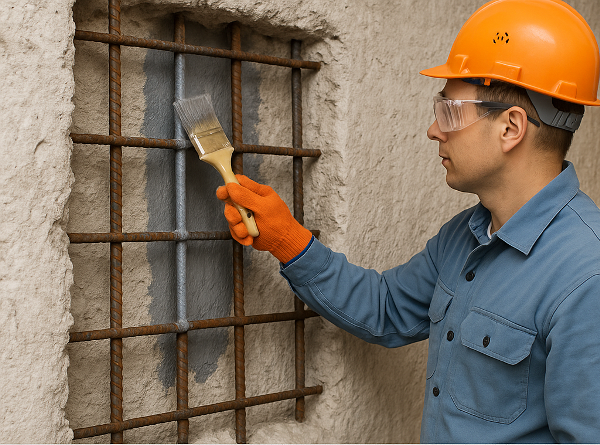4 Urgent Reasons Concrete Steel Should Have Corrosion Protection

Strong 8k brings an ultra-HD IPTV experience to your living room and your pocket.
Concrete steel reinforcement plays a pivotal role in the stability and durability of construction structures. Whether it’s a residential building, a bridge, or a skyscraper, steel is typically embedded within concrete to enhance the strength of the structure. However, steel is susceptible to corrosion, which can weaken the entire framework, leading to costly repairs, reduced lifespan, and even structural failures. The good news is that corrosion of steel reinforcement in concrete is preventable with proper protective measures. In this blog, we’ll explore why concrete steel should have corrosion protection and dive into the various methods available, including cathodic protection and waterproofing services.
What is Corrosion in Concrete Steel?
Corrosion in concrete steel refers to the deterioration of steel reinforcement caused by chemical reactions between the metal and the environment. In concrete structures, steel is protected initially by the high alkalinity of the concrete, which forms a passive oxide layer on the steel’s surface. However, this protective layer can break down due to various environmental factors such as moisture, chlorides from salt, and other aggressive chemicals. Once the protective layer is compromised, the steel begins to rust, expanding in volume and cracking the concrete around it. This corrosion weakens the steel, reducing its ability to carry loads, and accelerates the overall degradation of the concrete structure.
Why Should Concrete Steel Have Corrosion Protection?
The need for corrosion protection of concrete steel can’t be overstated, as it is directly tied to the structural integrity and longevity of buildings, roads, and other infrastructure. Here are four compelling reasons why concrete steel requires corrosion protection:
1. Protecting Structural Integrity
The primary role of steel reinforcement in concrete is to provide strength and stability. Corrosion weakens the steel, making it unable to effectively perform its function. This leads to a loss of load-bearing capacity, which can compromise the safety and functionality of the entire structure. Without corrosion protection, your building, bridge, or other concrete-based infrastructure is at a significant risk of structural failure. The impact of such failures could range from minor cracks and aesthetic damage to catastrophic collapse in severe cases. Therefore, ensuring corrosion protection is crucial for preserving the structural integrity of your property.
2. Increasing Longevity of Structures
The lifespan of a concrete structure is significantly reduced when the steel reinforcement is corroded. Corrosion accelerates the degradation process of both the steel and the surrounding concrete, shortening the structure’s usable life. On the other hand, when corrosion protection is applied, it can extend the life of the structure by preventing the steel from rusting. This is particularly important for large infrastructure projects like highways, bridges, and skyscrapers, where the cost of reconstruction or major repairs can be enormous.
3. Preventing Costly Repairs and Maintenance
Corrosion damage can lead to expensive repairs and maintenance work. When steel reinforcement corrodes, the concrete surrounding it may crack and become brittle, requiring resurfacing, patching, and even complete replacement in some cases. These repairs not only cost money but also take time, potentially causing disruptions to daily activities in the building or infrastructure. Corrosion protection methods such as cathodic protection or waterproofing services can prevent such issues from arising, saving both money and time in the long term. By investing in prevention, you avoid the heavy costs of damage control.
4. Ensuring Safety and Compliance
In many regions, construction projects must comply with local building codes and regulations. These regulations often mandate the use of corrosion protection in certain environments, particularly where structures are exposed to harsh conditions like marine environments, high humidity, or de-icing salts. Failure to meet these standards can result in legal penalties, project delays, and even safety hazards. Protecting steel reinforcement from corrosion ensures that a structure remains safe for its occupants and complies with relevant regulations.
The Importance of Corrosion Protection of Steel Reinforcement
Steel reinforcement plays a critical role in bearing tensile stresses in concrete structures. Without it, concrete, which is strong in compression but weak in tension, would not be able to support significant loads. The addition of steel reinforcement helps concrete withstand bending, stretching, and twisting forces.
However, as previously mentioned, the steel is vulnerable to corrosion. When steel reinforcement corrodes, it expands and exerts pressure on the surrounding concrete, leading to cracks. This reduces the strength of the concrete and ultimately compromises the integrity of the entire structure.
Methods for Corrosion Protection of Steel Reinforcement
Several methods can be employed to protect steel reinforcement from corrosion:
Coating the Steel: One of the most common methods involves applying a protective coating to the steel before embedding it in the concrete. These coatings can be in the form of epoxy, zinc, or other corrosion-resistant materials that prevent water and chemicals from coming into direct contact with the steel.
Use of Corrosion-Resistant Steel: In some cases, corrosion-resistant steel alloys, such as stainless steel, may be used in high-risk areas. These materials have better resistance to corrosion and may be more expensive but can be a worthwhile investment in certain applications.
Corrosion Inhibitors: Adding corrosion inhibitors to the concrete mix can help to protect the steel reinforcement. These chemicals create a barrier that inhibits the corrosive process, allowing the concrete to preserve its integrity for longer.
Cathodic Protection: This method involves the use of an external electrical current to counteract the electrochemical process of corrosion. It is particularly effective for reinforcing concrete structures exposed to harsh environmental conditions.
Cathodic Protection: A Vital Solution for Corrosion
Cathodic protection is a technique used to prevent the corrosion of metal surfaces, including steel reinforcement in concrete structures. It works by applying an electrical charge to the steel that counteracts the corrosive process, essentially stopping the oxidation of the metal.
What is Cathodic Protection?
Cathodic protection involves using a sacrificial anode or an impressed current system to protect the steel. The sacrificial anode is a more reactive material than the steel and corrodes instead of the steel, keeping the steel protected. In impressed current systems, a constant electrical current is applied to the steel to counterbalance the corrosion process.
How Cathodic Protection Prevents Corrosion
By shifting the electrochemical reaction from the steel reinforcement to the sacrificial anode or through the use of impressed current, cathodic protection keeps the steel from corroding, even when exposed to water, chlorides, and other harmful agents. This method is highly effective in protecting steel reinforcement in coastal areas, marine environments, and structures exposed to high levels of de-icing salts or moisture.
Cathodic Protection Services in Dubai: Why You Should Choose Them
In places like Dubai, where extreme temperatures, humidity, and proximity to saltwater can accelerate corrosion, cathodic protection services are crucial for maintaining the longevity of concrete structures. Cathodic protection services in Dubai specialize in providing solutions to protect steel reinforcement from the harsh environmental conditions prevalent in the region.
These services offer custom solutions for each project, ensuring that the appropriate type of cathodic protection is used for the structure’s specific requirements. Choosing the right provider can ensure that your concrete structures remain safe and durable for decades.
Waterproofing Services in Dubai: A Complement to Corrosion Protection
Waterproofing plays an integral role in protecting concrete structures from the elements. While corrosion protection primarily focuses on the steel reinforcement, waterproofing ensures that moisture doesn’t enter the concrete, where it can trigger corrosion. Waterproofing is especially important in regions like Dubai, where heavy rainfall, high humidity, and salt exposure are common.
Importance of Waterproofing for Concrete Structures
Waterproofing is essential to prevent the penetration of water into the concrete. When water seeps into the concrete, it can bring with it harmful salts, chemicals, and other agents that accelerate the corrosion of steel reinforcement. Additionally, trapped moisture in the concrete can lead to the formation of cracks and reduce the strength of the structure. Waterproofing services in Dubai address this problem by applying specialized coatings and sealants to the exterior of concrete structures.
How Waterproofing and Corrosion Protection Work Together
Waterproofing and corrosion protection go hand-in-hand in ensuring the durability of concrete structures. While corrosion protection safeguards the steel, waterproofing prevents water from getting inside and initiating the corrosion process in the first place. Together, these measures offer comprehensive protection for concrete structures, ensuring that they remain strong, stable, and resistant to environmental factors.
Finding the Best Waterproofing Services in Dubai
In Dubai, a variety of companies offer high-quality waterproofing services. These services include the application of advanced waterproofing membranes, coatings, and sealants designed to provide long-lasting protection. By choosing a reputable waterproofing service provider in Dubai, you can ensure that your concrete structure is protected from both water damage and corrosion, effectively extending its lifespan.
The Economic Benefits of Investing in Corrosion Protection
While the upfront cost of corrosion protection might seem high, it offers substantial long-term savings. By protecting your structure from the damaging effects of corrosion, you reduce the likelihood of expensive repairs, extend the lifespan of the building, and maintain its structural integrity. This not only saves money but also increases the overall value of your property. Additionally, a well-maintained structure is less likely to encounter regulatory issues, reducing the risk of costly compliance violations.
Challenges in Corrosion Protection
While corrosion protection is essential, it does come with its own set of challenges. Environmental factors such as extreme temperatures, exposure to salts, and high humidity levels can accelerate the process of corrosion, making protection methods less effective over time. Moreover, selecting the right corrosion protection strategy requires careful consideration of the specific environmental conditions and the material properties of the structure.
Note: IndiBlogHub features both user-submitted and editorial content. We do not verify third-party contributions. Read our Disclaimer and Privacy Policyfor details.


